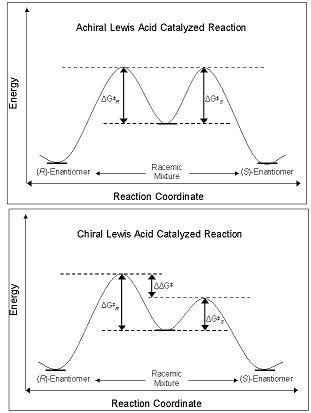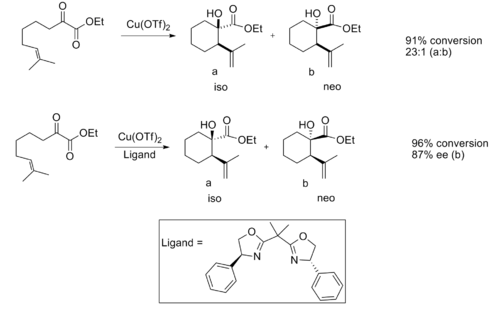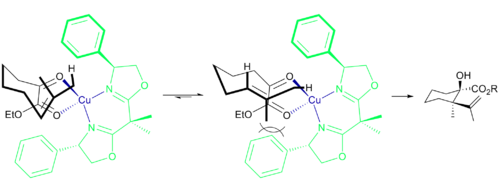
Chiral Lewis acid
Encyclopedia
Chiral Lewis acids are a novel class of Lewis acid
catalyst used in enantioselective asymmetric synthesis reactions which produce optically active products from optically inactive or impure starting materials. This type of preferential formation of one enantiomer
or diastereomer
over the other is formally an asymmetric induction
. The electron accepting atom of CLAs are typically metal, such as indium
, zinc
, lithium
, aluminium
, titanium
, or boron
– and the chiral
ligands employed for synthesizing CLAs most often have multiple Lewis basic sites (often diol
s or dinitrogen structures) to allow forming a ring structure involving the metal atom.
While the ability of achiral Lewis acids to promote the synthesis of racemic mixtures in myriad different reactions has been known for quite some time, starting in the 1960s, CLAs have been used to induce the enantioselectivity in these reactions. Common reaction types include Diels-Alder reactions, the ene reaction
, [2+2] cycloaddition
reactions, hydrocyanation
of aldehydes, and most notably, Sharpless expoxidations.
 The enantioselectivity of CLAs derives from their ability to perturb the free energy barrier along the reaction coordinate
The enantioselectivity of CLAs derives from their ability to perturb the free energy barrier along the reaction coordinate
pathway that leads to either the R- or S- enantiomer. Ground state diastereomers and enantiomers are of equal energy in the ground state, and when reacted with an achiral lewis acid, their diastereomeric intermediates, transition state
s, and products are also of equal energy. This leads to the production of racemic mixtures of products. However, when a CLA is utilized in the same reaction, the energetic barrier of formation of one diastereomer is less than that of another – the reaction is under kinetic control. If the difference in the energy barriers between the diastereomeric transition states are of sufficient magnitude, and high enantiomeric excess
of one isomer should be observed (Figure 2).
s occur between a conjugated diene
and an alkene
(commonly known as the dienophile). This cycloaddition
process allows for the stereoselective formation of cyclohexene
rings capable of possessing as many as four contiguous stereogenic centers.
Diels-Alder reactions can lead to formation of a variety of structural isomers and stereoisomers. The molecular orbital theory
considers that endo transition state, instead of the exo transition state, is favored (endo addition rule). Also, augmented secondary orbital interactions have been postulated as the source of enhanced endo diastereoselection.
 The addition of a CLA selectively activates one component of the reaction (the diene or dienophile) while providing a stereodefined environment that permits unique enantioselectivity.
The addition of a CLA selectively activates one component of the reaction (the diene or dienophile) while providing a stereodefined environment that permits unique enantioselectivity.
Koga and coworkers disclosed the first practical example of a catalytic enantioselective Diels-Alder reaction promoted by a CLA - menthoxyaluminum dichloride - derived from menthol and ethylaluminum dichloride.
 A decade later, Elias James Corey
A decade later, Elias James Corey
introduced an effective aluminum-diamine controller for Diels-Alder reaction. Formation of the active catalyst is achieved by treatment of the bis(sulfonamide) with trimethylaluminum; recovery of the ligand was essentially quantitative. The proposed tetracoordinate aluminum prevent the imide acting as a chelating Lewis base, while enhance the α-vinyl proton of the dienphile and the benzylic proton of the catalyst.
 The X-ray structure of the catalyst showed a stereodefined environment.
The X-ray structure of the catalyst showed a stereodefined environment.
 In 1993, Wulff and coworkers found a complex derived from diethylaluminium chloride and a “vaulted” biaryl ligand below catalyzed the enantioselective Diels-Alder reaction between cyclopentadiene and methacrolein. The chiral ligand is recovered quantitatively by silica gel chromatography
In 1993, Wulff and coworkers found a complex derived from diethylaluminium chloride and a “vaulted” biaryl ligand below catalyzed the enantioselective Diels-Alder reaction between cyclopentadiene and methacrolein. The chiral ligand is recovered quantitatively by silica gel chromatography
.
 Hisashi Yamamoto
Hisashi Yamamoto
and coworkers have developed a practical Diels-Alder catalyst for aldehyde dienophiles. The chiral (acyloxy)borane (CAB) complex is effective in catalyzing a number of aldehyde Diels-Alder reactions. NMR spectroscopic experiments indicated close proximity of the aldehyde and the aryl ring. Also, Pi stacking between the aryl group and aldehyde was suggested as an organizational feature which imparted high enantioselectivity to the cycloaddition.
 Yamamoto and co-wokers have introduced a conceptually interesting series of catalysts that incorporate an acidic proton into the active catalyst. This kind of what so called Bronsted acid-assisted chiral Lewis acid (BLA) catalyzes a number of diene-aldehyde cycloaddition reactions.
Yamamoto and co-wokers have introduced a conceptually interesting series of catalysts that incorporate an acidic proton into the active catalyst. This kind of what so called Bronsted acid-assisted chiral Lewis acid (BLA) catalyzes a number of diene-aldehyde cycloaddition reactions.

reaction, the diastereoselectivity of the product is often dictated by the geometry of the enolate according to the Zimmerman-Traxler model. The model predicts that the Z enolate will give syn
products and that E enolates will give anti
products. Chiral Lewis acids allow products that defy the Zimmerman-Traxler model, and allows for control of absolute stereochemistry
. Kobayashi and Horibe demonstrated this in the synthesis of dihydroxythioester derivatives, using a tin
-based chiral Lewis acid.
 The transition structures for reactions with both the R and S catalyst enantiomers are shown below.
The transition structures for reactions with both the R and S catalyst enantiomers are shown below.

 The Baylis-Hillman reaction is a route for C-C bond formation between an alpha, beta-unsaturated carbonyl
The Baylis-Hillman reaction is a route for C-C bond formation between an alpha, beta-unsaturated carbonyl
and an aldehyde
, which requires a nucleophilic catalyst, usually a tertiary amine
, for a Michael-type addition and elimination. The stereoselectivity of these reactions is usually poor. Chen et al. demonstrated an enantioselective chiral Lewis acid-catalyzed reaction. Lanthanum
was used in this case. Similarly a chiral amine may also be used to achieve stereoselectivity.
 The product obtained by the reaction using the chiral catalyst was obtained in good yield with excellent enantioselectivity.
The product obtained by the reaction using the chiral catalyst was obtained in good yield with excellent enantioselectivity.

. When catalyzed by an achiral lewis acid the reaction normally provides good diastereoselectivity.

When a chiral lewis acid catalyst was used good enantioselectivity was observed.

The enantioselectivity is believed to be due to the steric interactions between the methyl and phenyl group, which makes the transition structure of the iso product considerably more favorable.
catalyzed coupling of 1,3-dienes with aldehydes
In some cases an achiral Lewis acid may provide good stereoselectivity. Kimura et al. demonstrated the regio- and diasteroselective coupling of 1,3-dienes
with aldehydes.
mixture is both costly and wasteful.
Lewis acid
]The term Lewis acid refers to a definition of acid published by Gilbert N. Lewis in 1923, specifically: An acid substance is one which can employ a lone pair from another molecule in completing the stable group of one of its own atoms. Thus, H+ is a Lewis acid, since it can accept a lone pair,...
catalyst used in enantioselective asymmetric synthesis reactions which produce optically active products from optically inactive or impure starting materials. This type of preferential formation of one enantiomer
Enantiomer
In chemistry, an enantiomer is one of two stereoisomers that are mirror images of each other that are non-superposable , much as one's left and right hands are the same except for opposite orientation. It can be clearly understood if you try to place your hands one over the other without...
or diastereomer
Diastereomer
Diastereomers are stereoisomers that are not enantiomers.Diastereomerism occurs when two or more stereoisomers of a compound have different configurations at one or more of the equivalent stereocenters and are not mirror images of each other.When two diastereoisomers differ from each other at...
over the other is formally an asymmetric induction
Asymmetric induction
Asymmetric induction in stereochemistry describes the preferential formation in a chemical reaction of one enantiomer or diastereoisomer over the other as a result of the influence of a chiral feature present in the substrate, reagent, catalyst or environment...
. The electron accepting atom of CLAs are typically metal, such as indium
Indium
Indium is a chemical element with the symbol In and atomic number 49. This rare, very soft, malleable and easily fusible post-transition metal is chemically similar to gallium and thallium, and shows the intermediate properties between these two...
, zinc
Zinc
Zinc , or spelter , is a metallic chemical element; it has the symbol Zn and atomic number 30. It is the first element in group 12 of the periodic table. Zinc is, in some respects, chemically similar to magnesium, because its ion is of similar size and its only common oxidation state is +2...
, lithium
Lithium
Lithium is a soft, silver-white metal that belongs to the alkali metal group of chemical elements. It is represented by the symbol Li, and it has the atomic number 3. Under standard conditions it is the lightest metal and the least dense solid element. Like all alkali metals, lithium is highly...
, aluminium
Aluminium
Aluminium or aluminum is a silvery white member of the boron group of chemical elements. It has the symbol Al, and its atomic number is 13. It is not soluble in water under normal circumstances....
, titanium
Titanium
Titanium is a chemical element with the symbol Ti and atomic number 22. It has a low density and is a strong, lustrous, corrosion-resistant transition metal with a silver color....
, or boron
Boron
Boron is the chemical element with atomic number 5 and the chemical symbol B. Boron is a metalloid. Because boron is not produced by stellar nucleosynthesis, it is a low-abundance element in both the solar system and the Earth's crust. However, boron is concentrated on Earth by the...
– and the chiral
Chirality (chemistry)
A chiral molecule is a type of molecule that lacks an internal plane of symmetry and thus has a non-superimposable mirror image. The feature that is most often the cause of chirality in molecules is the presence of an asymmetric carbon atom....
ligands employed for synthesizing CLAs most often have multiple Lewis basic sites (often diol
Diol
A diol or glycol is a chemical compound containing two hydroxyl groups A geminal diol has two hydroxyl groups bonded to the same atom...
s or dinitrogen structures) to allow forming a ring structure involving the metal atom.
While the ability of achiral Lewis acids to promote the synthesis of racemic mixtures in myriad different reactions has been known for quite some time, starting in the 1960s, CLAs have been used to induce the enantioselectivity in these reactions. Common reaction types include Diels-Alder reactions, the ene reaction
Ene reaction
The Ene reaction is a chemical reaction between an alkene with an allylic hydrogen and a compound containing a multiple bond , in order to form a new σ-bond with migration of the ene double bond and 1,5 hydrogen shift. The product is a substituted alkene with the double bond shifted to the...
, [2+2] cycloaddition
Cycloaddition
A cycloaddition is a pericyclic chemical reaction, in which "two or more unsaturated molecules combine with the formation of a cyclic adduct in which there is a net reduction of the bond multiplicity." The resulting reaction is a cyclization reaction.Cycloadditions are usually described by the...
reactions, hydrocyanation
Hydrocyanation
Hydrocyanation is, most fundamentally, the process whereby H+ and –CN ions are added to a molecular substrate. Usually the substrate is an alkene and the product is a nitrile. When –CN is a ligand in a transition metal complex, its basicity makes it difficult to dislodge, so, in this...
of aldehydes, and most notably, Sharpless expoxidations.
Theory

Reaction coordinate
In chemistry, a reaction coordinate is an abstract one-dimensional coordinate which represents progress along a reaction pathway. It is usually a geometric parameter that changes during the conversion of one or more molecular entities....
pathway that leads to either the R- or S- enantiomer. Ground state diastereomers and enantiomers are of equal energy in the ground state, and when reacted with an achiral lewis acid, their diastereomeric intermediates, transition state
Transition state
The transition state of a chemical reaction is a particular configuration along the reaction coordinate. It is defined as the state corresponding to the highest energy along this reaction coordinate. At this point, assuming a perfectly irreversible reaction, colliding reactant molecules will always...
s, and products are also of equal energy. This leads to the production of racemic mixtures of products. However, when a CLA is utilized in the same reaction, the energetic barrier of formation of one diastereomer is less than that of another – the reaction is under kinetic control. If the difference in the energy barriers between the diastereomeric transition states are of sufficient magnitude, and high enantiomeric excess
Enantiomeric excess
The enantiomeric excess of a substance is a measure of how pure it is. In this case, the impurity is the undesired enantiomer .-Definition:...
of one isomer should be observed (Figure 2).
Diels-Alder reaction
Diels-Alder reactionDiels-Alder reaction
The Diels–Alder reaction is an organic chemical reaction between a conjugated diene and a substituted alkene, commonly termed the dienophile, to form a substituted cyclohexene system. The reaction can proceed even if some of the atoms in the newly formed ring are not carbon...
s occur between a conjugated diene
Diene
In organic chemistry a diene or diolefin is a hydrocarbon that contains two carbon double bonds.Conjugated dienes are functional groups, with a general formula of CnH2n-2. Dienes and alkynes are functional isomers...
and an alkene
Alkene
In organic chemistry, an alkene, olefin, or olefine is an unsaturated chemical compound containing at least one carbon-to-carbon double bond...
(commonly known as the dienophile). This cycloaddition
Cycloaddition
A cycloaddition is a pericyclic chemical reaction, in which "two or more unsaturated molecules combine with the formation of a cyclic adduct in which there is a net reduction of the bond multiplicity." The resulting reaction is a cyclization reaction.Cycloadditions are usually described by the...
process allows for the stereoselective formation of cyclohexene
Cyclohexene
Cyclohexene is a hydrocarbon with the formula C6H10. This cycloalkene is a colorless liquid with a sharp smell. It is an intermediate in various industrial processes...
rings capable of possessing as many as four contiguous stereogenic centers.
Diels-Alder reactions can lead to formation of a variety of structural isomers and stereoisomers. The molecular orbital theory
Molecular orbital theory
In chemistry, molecular orbital theory is a method for determining molecular structure in which electrons are not assigned to individual bonds between atoms, but are treated as moving under the influence of the nuclei in the whole molecule...
considers that endo transition state, instead of the exo transition state, is favored (endo addition rule). Also, augmented secondary orbital interactions have been postulated as the source of enhanced endo diastereoselection.

Koga and coworkers disclosed the first practical example of a catalytic enantioselective Diels-Alder reaction promoted by a CLA - menthoxyaluminum dichloride - derived from menthol and ethylaluminum dichloride.

Elias James Corey
Elias James Corey is an American organic chemist. In 1990 he won the Nobel Prize in Chemistry "for his development of the theory and methodology of organic synthesis", specifically retrosynthetic analysis...
introduced an effective aluminum-diamine controller for Diels-Alder reaction. Formation of the active catalyst is achieved by treatment of the bis(sulfonamide) with trimethylaluminum; recovery of the ligand was essentially quantitative. The proposed tetracoordinate aluminum prevent the imide acting as a chelating Lewis base, while enhance the α-vinyl proton of the dienphile and the benzylic proton of the catalyst.


Chromatography
Chromatography is the collective term for a set of laboratory techniques for the separation of mixtures....
.

Hisashi Yamamoto
is an organic chemist and currently a member of the faculty at the University of Chicago. Born in Kobe, Japan, Yamamoto earned a B.S. at Kyoto University in 1967 and a Ph.D. at Harvard University in 1971. He was a professor at Nagoya University from 1983 until 2002 and has since been a professor...
and coworkers have developed a practical Diels-Alder catalyst for aldehyde dienophiles. The chiral (acyloxy)borane (CAB) complex is effective in catalyzing a number of aldehyde Diels-Alder reactions. NMR spectroscopic experiments indicated close proximity of the aldehyde and the aryl ring. Also, Pi stacking between the aryl group and aldehyde was suggested as an organizational feature which imparted high enantioselectivity to the cycloaddition.


Aldol reaction
In the aldolAldol
An aldol or aldol adduct is a beta-hydroxy ketone or aldehyde, and is the product of aldol addition ....
reaction, the diastereoselectivity of the product is often dictated by the geometry of the enolate according to the Zimmerman-Traxler model. The model predicts that the Z enolate will give syn
SYN
Syn may refer to:*SYN , a band by HALCA *Doctor Syn, a character in novels by Russell Thorndike*Grand Admiral Peccati Syn character in the Star Wars expanded universe*Syn , in Norse mythology...
products and that E enolates will give anti
Anti
Anti may refer to:* Anti , the ferryman who carried Isis to Set's island in Egyptian mythology* Anti, or Campa, a tribe of South American Indians* ANTI – Contemporary Art Festival, a yearly international live-art festival held in Kuopio, Finland...
products. Chiral Lewis acids allow products that defy the Zimmerman-Traxler model, and allows for control of absolute stereochemistry
Stereochemistry
Stereochemistry, a subdiscipline of chemistry, involves the study of the relative spatial arrangement of atoms within molecules. An important branch of stereochemistry is the study of chiral molecules....
. Kobayashi and Horibe demonstrated this in the synthesis of dihydroxythioester derivatives, using a tin
Tin
Tin is a chemical element with the symbol Sn and atomic number 50. It is a main group metal in group 14 of the periodic table. Tin shows chemical similarity to both neighboring group 14 elements, germanium and lead and has two possible oxidation states, +2 and the slightly more stable +4...
-based chiral Lewis acid.


Baylis-Hillman Reaction

Carbonyl
In organic chemistry, a carbonyl group is a functional group composed of a carbon atom double-bonded to an oxygen atom: C=O. It is common to several classes of organic compounds, as part of many larger functional groups....
and an aldehyde
Aldehyde
An aldehyde is an organic compound containing a formyl group. This functional group, with the structure R-CHO, consists of a carbonyl center bonded to hydrogen and an R group....
, which requires a nucleophilic catalyst, usually a tertiary amine
Amine
Amines are organic compounds and functional groups that contain a basic nitrogen atom with a lone pair. Amines are derivatives of ammonia, wherein one or more hydrogen atoms have been replaced by a substituent such as an alkyl or aryl group. Important amines include amino acids, biogenic amines,...
, for a Michael-type addition and elimination. The stereoselectivity of these reactions is usually poor. Chen et al. demonstrated an enantioselective chiral Lewis acid-catalyzed reaction. Lanthanum
Lanthanum
Lanthanum is a chemical element with the symbol La and atomic number 57.Lanthanum is a silvery white metallic element that belongs to group 3 of the periodic table and is the first element of the lanthanide series. It is found in some rare-earth minerals, usually in combination with cerium and...
was used in this case. Similarly a chiral amine may also be used to achieve stereoselectivity.


Ene reaction
Chiral lewis acids have also proven useful in the ene reactionEne reaction
The Ene reaction is a chemical reaction between an alkene with an allylic hydrogen and a compound containing a multiple bond , in order to form a new σ-bond with migration of the ene double bond and 1,5 hydrogen shift. The product is a substituted alkene with the double bond shifted to the...
. When catalyzed by an achiral lewis acid the reaction normally provides good diastereoselectivity.

When a chiral lewis acid catalyst was used good enantioselectivity was observed.

The enantioselectivity is believed to be due to the steric interactions between the methyl and phenyl group, which makes the transition structure of the iso product considerably more favorable.
Examples of achiral Lewis acids in stereoselective synthesis
NickelNickel
Nickel is a chemical element with the chemical symbol Ni and atomic number 28. It is a silvery-white lustrous metal with a slight golden tinge. Nickel belongs to the transition metals and is hard and ductile...
catalyzed coupling of 1,3-dienes with aldehydes
In some cases an achiral Lewis acid may provide good stereoselectivity. Kimura et al. demonstrated the regio- and diasteroselective coupling of 1,3-dienes
Dienes
Dienes may mean:* People: see Dienes for a list of people with the surname Dienes.* Dienes are a type of chemical compound....
with aldehydes.
Utility of chiral Lewis acids
Asymmetric synthesis and production of enantiomerically pure substances through the use of CLAs is of particular interest to organic chemists and pharmaceutical corporations. Because many pharmaceuticals target enzymes which are specific for a particular enantiomer, compounds intended for patient administration must be of a high optical purity. Furthermore, resolution of a particular enantiomer from a racemicRacemic
In chemistry, a racemic mixture, or racemate , is one that has equal amounts of left- and right-handed enantiomers of a chiral molecule. The first known racemic mixture was "racemic acid", which Louis Pasteur found to be a mixture of the two enantiomeric isomers of tartaric acid.- Nomenclature :A...
mixture is both costly and wasteful.

